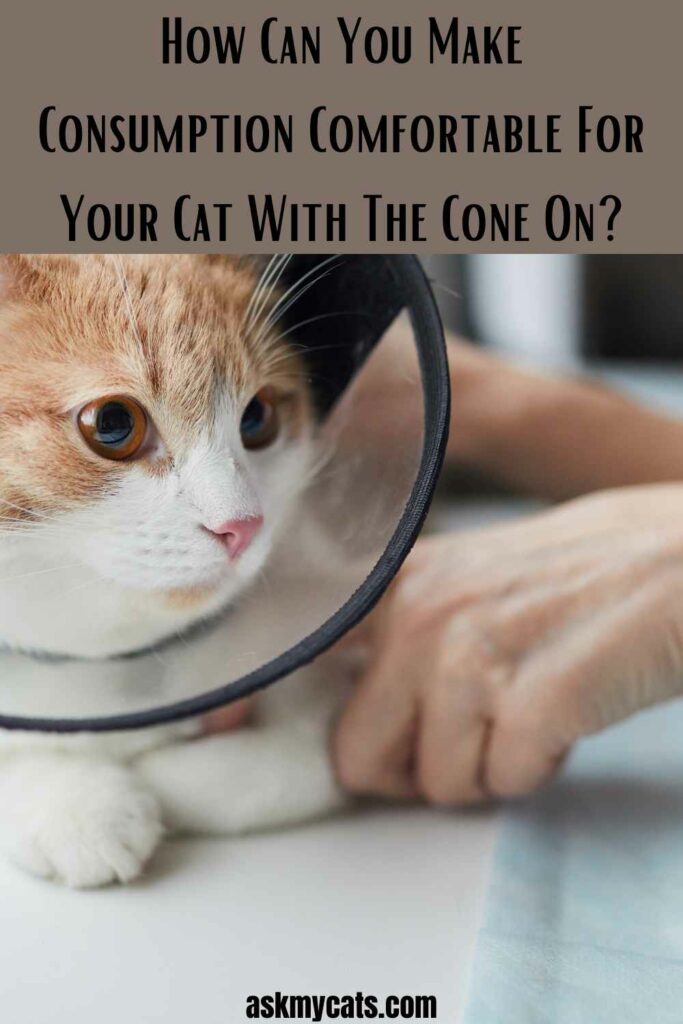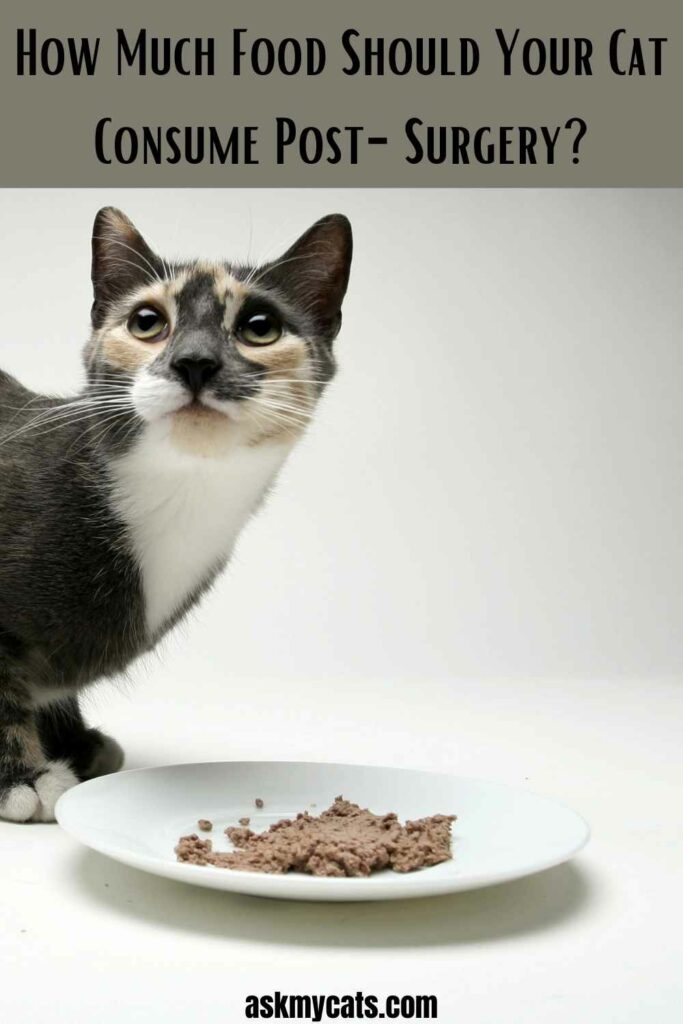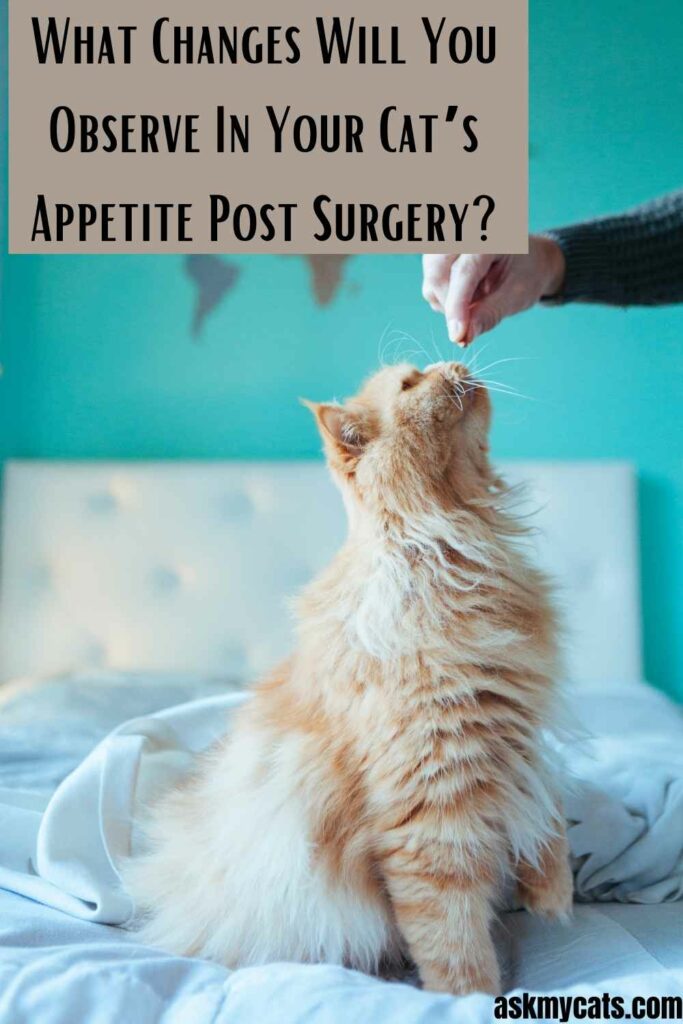Yes, you can feed your cat with its cone on and you can control your cat’s diet too.
There are several ways by which you can feed your cat with a cone on. Though it can be challenging for you.
Your cat will soon get used to eating with the cone around its neck.
To know more about how you can control your cat’s diet and feed it with the cone post-surgery, you should read this article further.


Give Your Cat the Perfect Day
Get the Free Ebook!
Can Your Cat Eat With A Cone On?
Yes, your cat should be able to eat with a cone on.
The cone should fit well on your cat though. While your cat may prefer eating from a saucer or a bowl. Your cat might even refuse to eat with the cone on.
In such scenarios contact your vet.
How Can You Make Consumption Comfortable For Your Cat With The Cone On?

1. Cone Should Fit Your Cat Properly
Make sure that the size of the cone you choose for your cat is the right size for it. You should ask your vet for advice before you get your cat a cone.
The cone should not be too big as it will become heavy for your cat and not too small that it cannot keep your cat from licking the wound.
Both of these scenarios could get uncomfortable for your cat.
To get the proper size of a cone for your cat, you should measure the length running from the base of the neck to your cat’s nose.
When the cone/collar is worn it should be long enough to be able to reach past the nose of your cat.
You should be able to fit at least two fingers between the neck of your cat and the base of the collar.
Most importantly your cat should be able to eat and breathe comfortably with the cone on.
2. Set Up Food And Water For Your Cat
You will have to raise the bowls and dishes to 2 to 4 inches above the ground level so that it is easy for your cat to eat and drink from them.
If your cat is clumsy in the start with the cone on, then you should consider keeping a mat beneath the food and water containers so that it is easier for you to clean up the mess if caused.
Try using a saucer if your is uncomfortable with the bowls you are already providing. It is maybe more comfortable for your cat to drink out of it.
If you are using a saucer then you should choose then one with a small diameter than the cone your cat is wearing so that your cat can easily eat from them.
Your cat might want to eat and drink when the cone is newly introduced to it and so you could try hand feeding her in the beginning so that she can get used to eating with a cone on.
But even then if your cat does not eat with the cone on, you could, with the advice of your vet remove the cone while your cat eats.
Interesting Read: Can I Feed My Cat After Neutering?
3. Give Your Cat A Break
You can give your cat a break from the collar/cone but make sure you can completely focus on your cat during those times.
You could remove the collar of your cat during certain periods but if your cat is trying to lick the wound or scratch the stitches it is time to put the cone on as it would cause more trouble and you will have to take your cat to the vet.
Your cat should be thrilled and relieved once the cone is removed. Your cat should heal soon if you take proper care.
In some time your cat will get used to the cone and will be able to drink and eat comfortably.
You might be like to check out can i take my cats cone off after 7 days
How Can You Introduce Your Cat To A Cone Using Wet Food?
Start by holding the cone near the cat but not on your cat for now. Then whenever your cat touches or sniffs it or even glances at the cone offer your cat a play or a treat
We do this as our first step as it creates a positive association for your cat and hence introducing the cone to your cat.
Your cat will like the cone then.
Now, you can start placing the cone on your cat and then taking it off. Whenever you make your cat wear it offer your cat a spoon of wet food/treat.
Make sure you feed your cat the wet food.
It serves as the basis of getting rewarded for wearing it.
Make sure you make your cat wear the cone only for a short time at first or even a few seconds and then take it off and give a treat of wet food to your cat.
Gradually start increasing the time your cat would wear the cone but if your cat freezes at any time or experiences discomfort, try to take the cone off then you should return to step one and keep it for less time.
Gift your cat its favorite toy or wet food as a reward or keep the cone on. Hence they will want to keep the cone on more.
If you see that your cat is feeling uncomfortable roaming around with its cone on then you should motivate them to walk around with a treat, wet food, or toy.
You bring in body awareness.
You should reward and praise your cat every time it wears the cone and it should soon start feeling comfortable with the cone on.
You also like to read about how long to keep cone on cat after spay
Will My Cat Be Able To Drink Water With A Cone On?
Yes, your cat will be able to drink water normally if it is wearing a proper fit E- collar.
It may take a while for your cat to adjust and adapt. Though it could get messy in the beginning.
Just make sure you keep the bowl at an elevation that is comfortable for your cat. Choose the bowls that are well fitted for your cat so it can easily drink water from them.
Your cat’s cone should be small enough that your cat can extend its tongue and be able to drink water comfortably.
You should ask your vet for advice if your cat is not able to drink water. There might be alternatives that you could use for your cat then.
How Is A Cone Friendly Cat Bowl Helpful?
A cone-friendly cat bowl allows the cone of your cat to fit easily over the bowl and so there is no kibble and straining because of the cone.
Owners who already use it say that their cats eat only from this bowl and their old bowls.
It is best if your cat makes jerky movements while eating as it has worn the cone and ends up pushing the bowl with the cone then your cone-friendly cat bowl may not even tip over.
Also, check out do cat depressed wearing cone
How Much Food Should Your Cat Consume Post-Surgery?
Two hours after the surgery you should serve your cat approximately half the quantity of food and water of your cat’s normal quantity that used to be consumed.

Make sure you feed your cat as soon as you return home if your cat is under 16 weeks of age. Feed your cat only half of its normal daily diet.
You should rub a maple on your cat’s gums if your cat/kitten refuses to eat after returning home.
You should not be scared while doing this as your cat will not bite or scratch you.
Your cat might not eat on the night it has returned from surgery.
If your cat does not it in the evening of the day of the surgery then you should serve your cat food and water as you normally would do on the next post-surgery.
Make sure you do not force your cat to eat the food on the night after the surgery or until the next day.
Your cat may end up puking after eating. You should take away the food from it immediately but leave the water next to your cat.
The next morning serve only a little amount of food to your cat, if it still pukes then consult your vet.
You can remove your cat’s E-collar while they are eating but make sure to supervise them. If you are not around do not remove the E-collar.
Make sure to put the E-collar back as soon as the meal is done.
Interesting Read: Cat Not Eating After Spay: Reasons & Solutions
Do Female Cats Consume More Post-Surgery?
Female cats/kittens who are spayed consumed more food after four weeks of the surgery than once they had healed.
They kept consuming more quantity of food until almost 10 weeks after the spay.
Though by the 18th-week post-surgery both the spayed and unspayed female cats were consuming almost the same quantity of food.
What Should You Do If Your Cat Wants To Eat More After Spay?
In some cases, it is observed that a cat has a greater intake of food post-surgery compared to the intake pre-surgery.
Though the reason for the increase in the consumption of food post-surgery is still unknown.
This increased consumption can affect your cat a lot health-wise.
Research figured that male cat consumes at least 50% more and so their body weight increases by almost 30%. Female cats have also encountered similar outcomes.
To prevent your cat from having an increased appetite and becoming over-weight let us follow some guidance-
Though we don’t know why your cat might want to eat so much after the spay surgery it could cause a problem of increased calories inside your cat and hence bring in an imbalance in the energy level of your cat.
- As owners, you need to compensate for your cat’s calorie intake. After all, you are responsible for your cat’s well-being.
- If you do not want your cat to become fat and lazy then you should not give your cat free access to its food.
- You should measure the meals you serve your cat throughout the entire day and adjust the size of the meals to maintain the calorie intake and body weight of your cat after its spay/neuter surgery.
- Make sure you give importance to maintaining your cat’s body weight after spay by taking care of its diet and body condition.
- You need to observe your cat for at least six months post-surgery.
What Change Should You See In Your Cat’s Appetite After 48 Hours Of Spay?
Your cat will have a reduced appetite for the 48 hours after surgery but then your cat’s appetite (food consumption) should increase by almost 30% as then your cat will not be able to control its hunger.
Females have a higher intake of food than males after 3 months of spay.
What Changes Will You Observe In Your Cat’s Appetite Post Surgery?
The amount of food your cat consumed pre-surgery and post-surgery shall be different.

The digestive tract and the body of your cat cannot handle the same quantity of food as they could pre-surgery.
A lot of the energy inside your cat’s body is directed towards the healing process and not much energy is given to the digestive process.
Your cat could vomit the food it has consumed on that day after the surgery and at that time you should ask your vet if you should continue or change the feeding plan for your cat.
You should always ask your vet all doubts about your cat’s feeding plan
Most vets will ask you to give your cat a small portion of food after the discharge.
You could give your cat only half the portion of food depending on the type of surgery and instructions of the vet.
You should make sure to consult your vet if these symptoms persist for a long.
You may have to feed your cat through a feeding tube and ask your vet the best way you could perform this task for your dear cat.
You should remove the cone around your cat’s neck while it is eating if it interferes.
Make sure to put the collar/cone around your cat’s neck immediately so that your cat does not lick or scratch its wound causing more harm to themselves.
What To Feed Your Cat After The Surgery?
There might be a recovery diet your vet may suggest you follow for your cat who is getting better from its surgery.
The recovery diet is necessary for your cat post-operation as it would give your cat all the nutrients it requires to return to its proper health and reduces its digestive workload.
Your cat will need to consume a small portion of this to get the energy and nutrients it requires as this food contains a lot of fat, proteins, and calories hence making it an energy-filled food for your cat.
The recovery diet of your cat will contain proteins that will help in the growth and rebuilding of cells which are highly digestible and hence also easy to absorb.
Your cat may have a reduced appetite right after the surgery and so any recovery diet has to be palatable and would serve as an appetizer for your cat with a properly shaped kibble to motivate your cat to eat it up.
Interesting Read: How To Pick Up Cat After Spaying?
Frequently Asked Questions
Why Is Your Cat Not Able To Consume The Same Amount Of Food After Surgery?
The energy that your cat previously used for proper absorption of nutrients and digestion of food is now used for speeding up the healing process. Hence your cat’s body and digestive tract can’t cope with the same quantity of food digestion as they could before the surgery.
How to take care of your cat once it is back from surgery?
You should keep your cat comfortable and warm after it has had a spay surgery, put your cat in a soft and clean bed which should be located in a cat-proof room. The room’s temperature should be between 20-24 degrees Celsius or between 68-75 degrees Fahrenheit and make sure your cat stays indoors until it recovers.
How Long Can Your Cat Survive Without Eating After Spay Surgery?
Your cat could have an upset stomach after anesthesia and would not feel like eating for two days after the surgery. Due to the surgery, your cat could face slight behavioral changes.
Final Words
Through this article, your cat should live a balanced and fit life even after the spay surgery. It is your responsibility to keep your cat healthy after its surgery.
Do not worry if your cat has less appetite after spay but take care of your cat’s appetite increasing after spay.
Keep calm and take decisions only after the advice of your vet.
For more questions, add them to our comment section.
